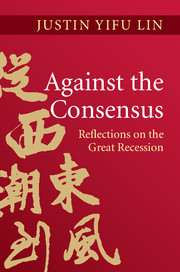Book contents
- Frontmatter
- Contents
- List of figures
- List of tables
- List of boxes
- Preface
- Overview
- Part I What Caused the 2008–9 Global Crisis?
- 1 The world economy and the 2008–9 crisis
- 2 The real causes of the crisis
- 3 Financial deregulation and the housing bubble
- 4 What’s wrong with the Eurozone
- 5 Why China’s reserves have risen so much
- Part II A Win-Win Path to Recovery
- Part III How Poor Countries Can Catch Up: Flying Geese and Leading Dragons
- Part IV Toward a Brave New World Monetary System
- References
- Index
5 - Why China’s reserves have risen so much
from Part I - What Caused the 2008–9 Global Crisis?
Published online by Cambridge University Press: 05 June 2013
- Frontmatter
- Contents
- List of figures
- List of tables
- List of boxes
- Preface
- Overview
- Part I What Caused the 2008–9 Global Crisis?
- 1 The world economy and the 2008–9 crisis
- 2 The real causes of the crisis
- 3 Financial deregulation and the housing bubble
- 4 What’s wrong with the Eurozone
- 5 Why China’s reserves have risen so much
- Part II A Win-Win Path to Recovery
- Part III How Poor Countries Can Catch Up: Flying Geese and Leading Dragons
- Part IV Toward a Brave New World Monetary System
- References
- Index
Summary
If the global imbalances resulted from the excess liquidity created by reserve currency countries – particularly the United States, through its expansionary monetary and fiscal policies and its housing finance policies – rather than a global savings glut brought about by the economic policies of China and East Asian economies, why did China’s current account surplus rise so much and attract so much attention? What was the role of China’s policies and saving rate in the evolution of the global crisis?
This chapter argues that China’s current account surplus was caused by the country’s high corporate saving rate, resulting from its dual-track reform strategy, and by the relocation of the labor-intensive tradables sectors of East Asian economies to China in the 1980s, which accelerated after China’s accession to the World Trade Organization in 2001.
China’s dual-track reform strategy led to high corporate savings
China’s large current account surplus reflects a high ratio of savings to investments. Saving and investment rates have both been extremely high in recent years. With a current account surplus equivalent to more than 0.5 percent of global GDP since 2005, China has accumulated more foreign reserves than the combined reserves of all industrial countries. While household savings are high, however, at about 20 percent of GDP they are not much higher than in India and some other Asian countries. China’s corporate saving rate is substantially higher than that of other Asian countries and other emerging market economies, however.
- Type
- Chapter
- Information
- Against the ConsensusReflections on the Great Recession, pp. 56 - 64Publisher: Cambridge University PressPrint publication year: 2013



